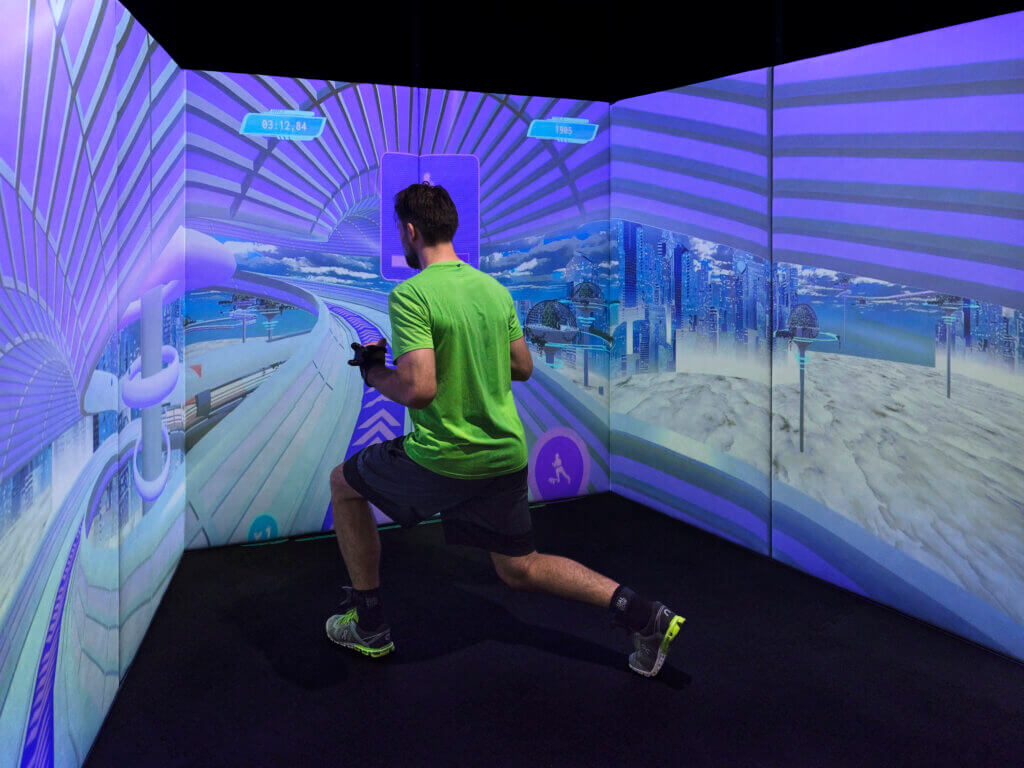
Cruciate ligament injuries are among the most common injuries in sport. Researchers at the ZHAW and ZHdK have developed the ExerUp game in collaboration with a practice partner to help people return to their previous level of activity in addition to physiotherapy.
A movement-based game is designed to support injured athletes after a cruciate ligament injury as part of physiotherapy and rehabilitation. Researchers from the ZHAW Department of Health have developed a so-called exergame together with a research team from the Zurich University of the Arts ZHdK and the practice partner Sphery. In the ExerUp Game, the game world is projected onto the three walls of an open cube measuring around three by three meters. The athletes solve physical and mental challenges in the ExerCube by performing typical rehabilitation exercises such as squats, lateral jumps or lunges. Movement trackers on the body ensure that the exercises are performed correctly.
Playful addition to sports rehabilitation
Cruciate ligament injuries are among the most common injuries in many sports and require around 9 to 12 months of rehabilitation. Due to the high re-injury rate, there is a need for additional therapeutic measures during rehabilitation. The game should only be used after the athletes have undergone strength and mobility training. “The game is not intended to replace rehabilitation, but rather to supplement it in a targeted manner before the athletes return to sport,” says Eveline Graf, Head of the Movement Laboratory at the ZHAW Department of Health. Feedback from physiotherapists and patients has shown that the intuitive operation and appealing design make it easy to train on your own. “This can relieve the physical, temporal and cognitive burden on physiotherapists,” says Eveline Graf. Finally, it still needs to be clarified how generic stimuli need to be designed to ensure a transfer effect into sport.
From fitness machine to physiotherapy game
The exergame was developed by game designers and design researchers from ZHdK, movement scientists from ZHAW and the ZHdK spin-off Sphery, which specializes in versatile exergame experiences with the ExerCube. “Exergames are ideally effective and attractive. During development, we therefore rely on a combination of interdisciplinary science and state-of-the-art design for the maximum physical-cognitive training effect and gaming fun,” says Anna Lisa Martin-Niedecken, Head of the Institute for Design Research at ZHdK and founder and CEO of Sphery.
Sphery’s ExerCube has been in use as a training device in the fitness and health sector since 2019, including at three locations in Switzerland. There has not yet been a specific offering for sports rehabilitation. In order to simulate the physical and cognitive demands of sport, the game’s exercises are controlled at the beginning and then become increasingly complex. “In principle, the new exergame can not only be used by competitive athletes in rehabilitation. Amateur athletes can also benefit from it as a preventative measure or after an injury, and it can also be used for fitness training in addition to the other ExerCube games,” says Anna Lisa Martin-Niedecken.
This media release was published on 30.11.23 on ZHAW.
ExerUp was funded aby DIZH in the 1st DIZH project call.